Bioethanol Market Size
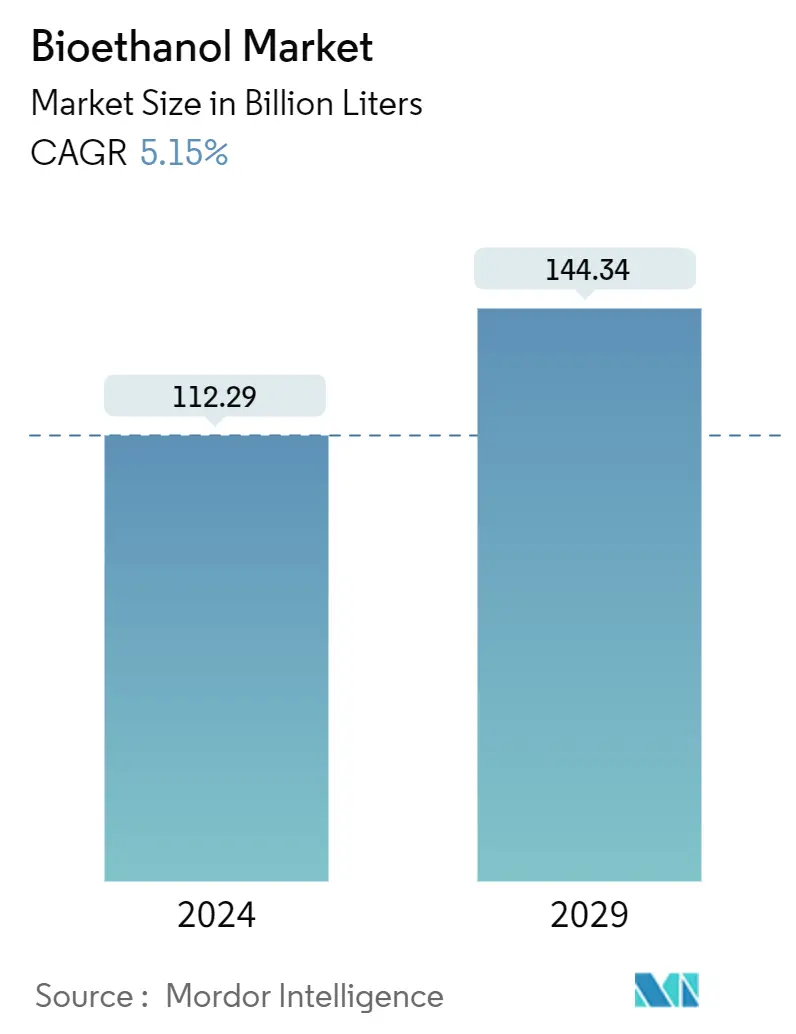
| Study Period | 2019 - 2029 |
| Base Year For Estimation | 2023 |
| CAGR (2024 - 2029) | 5.15 % |
| Fastest Growing Market | Asia-Pacific |
| Largest Market | North America |
| Market Concentration | Low |
Major Players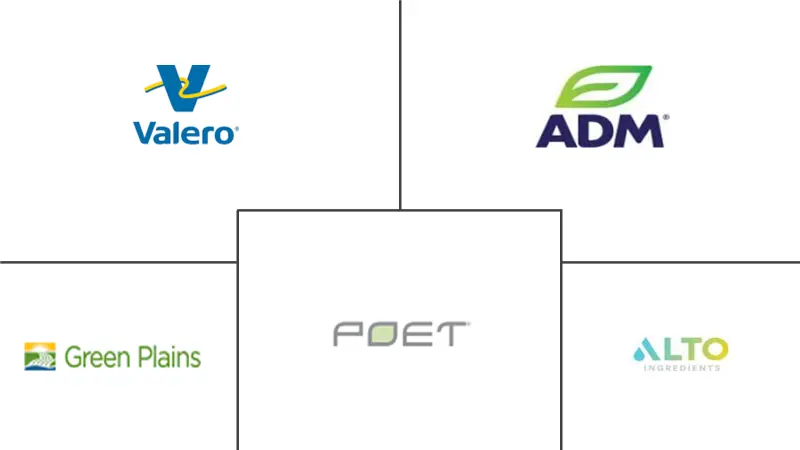
*Disclaimer: Major Players sorted in no particular order |
Bioethanol Market Analysis
The Bioethanol Market size is estimated at 112.29 Billion liters in 2024, and is expected to reach 144.34 Billion liters by 2029, growing at a CAGR of 5.15% during the forecast period (2024-2029).
The Bioethanol Market was adversely affected by COVID-19 due to disruptions in the supply chain. However, the market rebounded in 2021. The major factors driving the market were the increasing government initiatives and the increased restrictions on marketing gasoline containing a higher percentage of ethanol in the United States.
- Over the short term, increasing favorable initiatives, blending mandates by regulatory bodies, and rising environmental concerns about the use of fossil fuels and the need for biofuels are the factors driving the market's growth.
- Phasing out of fuel-based vehicles due to rising demand for electric cars and shifting focus to bio-butanol are the factors hindering the market's growth.
- Developing second-generation bio-ethanol production and increasing consumption of biofuels like bioethanol in the aviation industry is likely to create opportunities for the market in the future.
- North America dominated the global market, with the United States having the most significant consumption.
Bioethanol Market Trends
Increasing Usage in the Automotive and Transportation Sector
- The most extensive bioethanol applications are fuel and fuel additives in the automotive and transportation industries. It is used alongside conventional petrol to fuel petrol engines in road vehicles. It can also produce ETBE (ethyl-tertiary-butyl-ether), an octane booster used in many types of petrol.
- Blending bioethanol with conventional fuels improves its renewability. E10 energy is so named because it contains 10% ethanol. Bioethanol is a low-carbon fuel that may help to decarbonize the transport industry.
- In the United States, tax incentives have been provided to gasoline marketers for using bio-ethanol as an octane enhancer and gas extender over the past three decades. This has driven boosted the usage of bio-ethanol in this sector.
- Biofuel producers in the United States received a boost from the latest legislation, which encompasses funding and critical tax credits for producing low-carbon fuels. Funding of USD 500 million was allocated for biofuel infrastructure improvements by installing storage tanks and related equipment for ethanol-biodiesel blends.
- In 2022, according to OICA data, the overall production of automobiles increased by 6% compared to 2021. The global automotive production in 2022 was around 85.02 million units.
- The Asia-Oceania and Americas regions recorded automotive production of 50.02 million and 17.75 million units in 2022, registering an increase of nearly 7% and 10%, respectively, compared to 2020. However, Europe recorded a production of 16.21 million units in 2022, a decrease of 1% from the production achieved in 2021.
- Furthermore, in 2021, the United States Department of Energy announced to provide USD 64.7 million in funds for research and development projects dedicated to producing low-cost biofuels as fossil-fuel replacements for heavy-duty transportation like airplanes to bolster America's commitment to reaching net-zero emissions by 2050.
- With various economies announcing their plans to increase bio-ethanol consumption in fuels, the demand for bio-ethanol will likely surge during the forecast period.
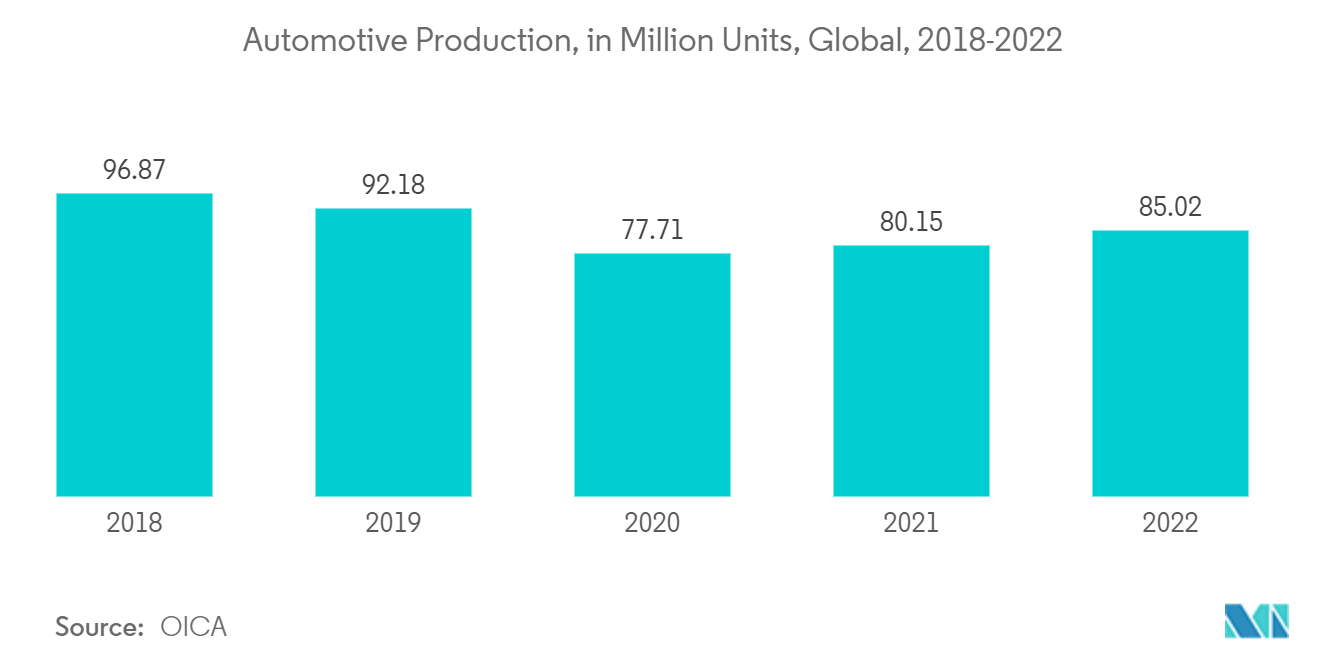
North America Region to Dominate the Market
- The North American region is dominating the bioethanol market share. The United States is the largest producer of bioethanol globally, followed by Brazil, China, India, and Canada. It is also the largest consumer of bioethanol.
- In recent years, bioethanol production has increased due to higher renewable fuel standard (RFS) targets and growth in domestic motor gasoline consumption, almost all of which is now blended with 10% ethanol by volume.
- In 2022, the overall production of automobiles in North America was around 14.79 million units compared to 13.46 million units in 2021.
- Around 93% of the country's 263 million registered automobiles may operate on E15. Furthermore, around 22 million flex-fuel vehicles (FFVs) in the United States can run on ethanol blends up to E85.
- The Canadian Clean Fuel Standard requires liquid fuel (gasoline, diesel, and home heating oil) suppliers to gradually reduce the carbon intensity of the fuels they produce and sell for use in Canada over time, resulting in a reduction in the carbon intensity of liquid fuels used in Canada of approximately 13% (below 2016 levels) by 2030.
- Some initiatives include the Canadian government's recent USD 1.5 billion investment in a Low-carbon and Zero-Emissions Fuels Fund, which may enhance support for local production and adoption of low-carbon fuels like hydrogen and biofuels.
- Due to all the factors mentioned above, the demand in the market studied is expected to increase in the North American region.
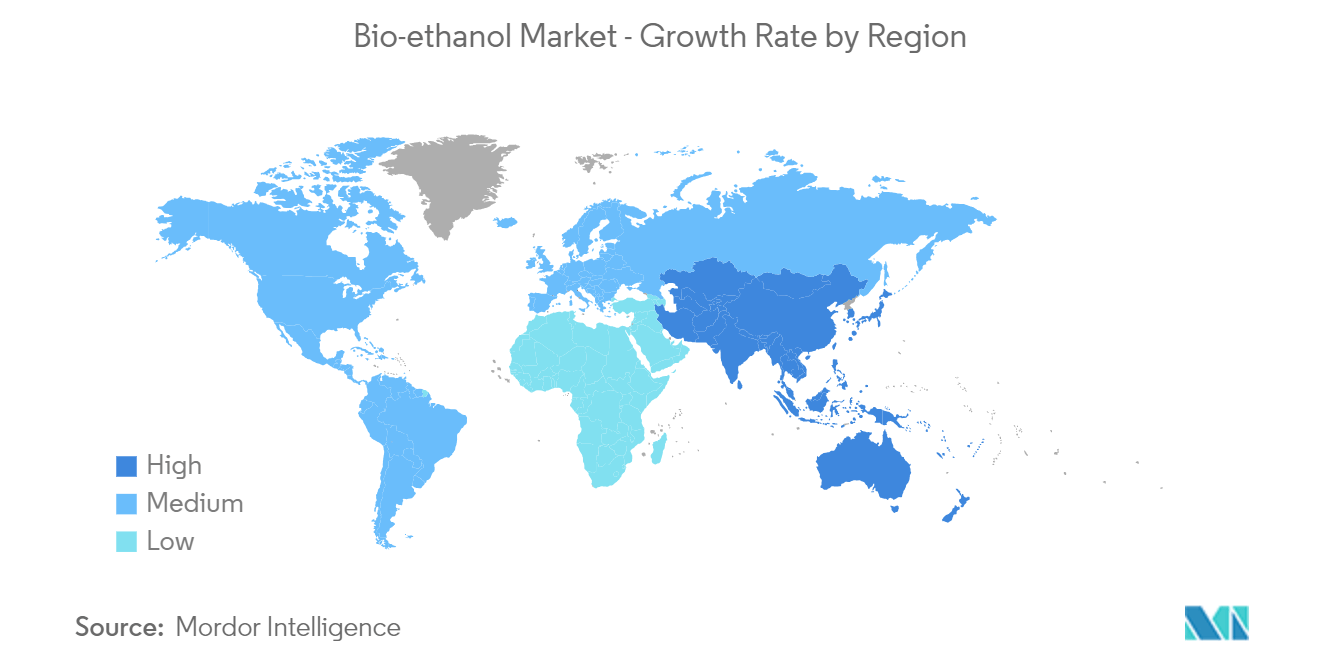
Bioethanol Industry Overview
The Bioethanol Market is moderately fragmented. Some major players in the market (not in any particular order) include POET LLC, Valero, ADM, Green Plains Inc., and Alto Ingredients Inc., among others.
Bioethanol Market Leaders
-
POET, LLC.
-
Valero
-
ADM
-
Green Plains Inc.
-
Alto Ingredients Inc
*Disclaimer: Major Players sorted in no particular order
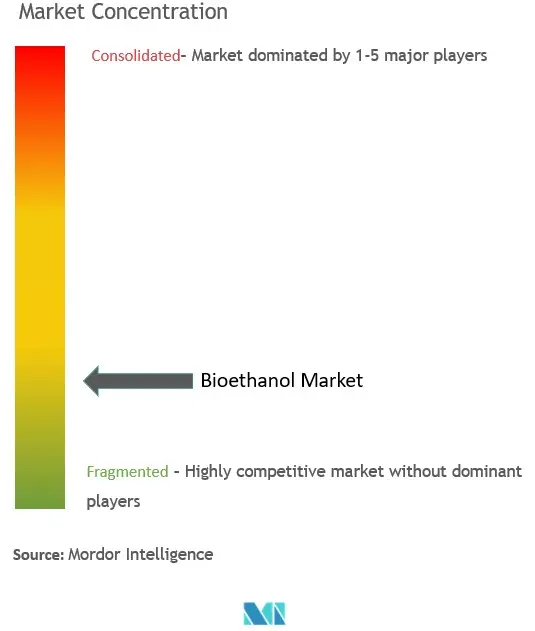
Bioethanol Market News
- January 2023: United Airlines, Tallgrass, and Green Plains Inc. announced a joint venture with Blue Blade Energy to develop and commercialize a novel Sustainable Aviation Fuel (SAF) technology that uses ethanol feedstock.
- September 2022: CropEnergies AG has acquired a stake in the Dutch start-up for biobased chemicals Syclus BV, Maastricht. The company's goal is to build an industrial-scale plant to produce renewable ethylene from renewable ethanol.
- May 2022: Blue Biofuels Inc. announced that its fifth generation of the Cellulose-to-Sugar ("CTS") machine is on schedule and that testing and further engineering toward larger volumes have started. Additionally, Blue Biofuels has laid the roadmap forward and contracted K.R. Komarek Inc. to build the successors of the fifth-generation CTS machine through commercialization.
Bioethanol Market Report - Table of Contents
1. INTRODUCTION
- 1.1 Study Assumptions
- 1.2 Scope of the Report
2. RESEARCH METHODOLOGY
3. EXECUTIVE SUMMARY
4. MARKET DYNAMICS
-
4.1 Drivers
- 4.1.1 Increasing Favorable Initiatives and Blending Mandates by Regulatory Bodies
- 4.1.2 Rising Environmental Concerns by the Use of Fossil Fuels and Need for the Bio-fuels
-
4.2 Restraints
- 4.2.1 Phasing out of Fuel-based Vehicles Due to Rising Demand for Electric Vehicles
- 4.2.2 Shifting Focus to Bio-butanol
- 4.3 Industry Value Chain Analysis
-
4.4 Porter's Five Forces Analysis
- 4.4.1 Bargaining Power of Suppliers
- 4.4.2 Bargaining Power of Buyers
- 4.4.3 Threat of New Entrants
- 4.4.4 Threat of Substitute Products and Services
- 4.4.5 Degree of Competition
5. MARKET SEGMENTATION (Market Size in Volume)
-
5.1 Feedstock Type
- 5.1.1 Sugarcane
- 5.1.2 Corn
- 5.1.3 Wheat
- 5.1.4 Other Feedstock Types
-
5.2 Application
- 5.2.1 Automotive and Transportation
- 5.2.2 Food and Beverage
- 5.2.3 Pharmaceutical
- 5.2.4 Cosmetics and Personal Care
- 5.2.5 Other Applications
-
5.3 Geography
- 5.3.1 Asia-Pacific
- 5.3.1.1 China
- 5.3.1.2 India
- 5.3.1.3 Japan
- 5.3.1.4 South Korea
- 5.3.1.5 Rest of Asia-Pacific
- 5.3.2 North America
- 5.3.2.1 United States
- 5.3.2.2 Canada
- 5.3.2.3 Mexico
- 5.3.3 Europe
- 5.3.3.1 Germany
- 5.3.3.2 United Kingdom
- 5.3.3.3 France
- 5.3.3.4 Italy
- 5.3.3.5 Rest of Europe
- 5.3.4 South America
- 5.3.4.1 Brazil
- 5.3.4.2 Argentina
- 5.3.4.3 Rest of South America
- 5.3.5 Middle-East and Africa
- 5.3.5.1 Saudi Arabia
- 5.3.5.2 South Africa
- 5.3.5.3 Rest of Middle-East and Africa
6. COMPETITIVE LANDSCAPE
- 6.1 Mergers and Acquisitions, Joint Ventures, Collaborations, and Agreements
- 6.2 Market Share (%)**/Ranking Analysis
- 6.3 Strategies Adopted by Leading Players
-
6.4 Company Profiles
- 6.4.1 Abengoa
- 6.4.2 ADM
- 6.4.3 Alto Ingredients Inc.
- 6.4.4 Blue Bio Fuels Inc.
- 6.4.5 Cenovus Inc.
- 6.4.6 Cristalco
- 6.4.7 Cropenergies AG
- 6.4.8 Ethanol Technologies
- 6.4.9 Granbio Investimentos SA
- 6.4.10 Green Plains Inc
- 6.4.11 Henan Tianguan Group Co. Ltd
- 6.4.12 Jilin Fuel Ethanol Co. Ltd
- 6.4.13 KWST
- 6.4.14 Lantmannen
- 6.4.15 Poet LLC
- 6.4.16 Raizen
- 6.4.17 Sekab
- 6.4.18 Suncor Energy Inc.
- 6.4.19 Tereos
- 6.4.20 Valero
- 6.4.21 Verbio Vereinigte Bioenergie AG
- *List Not Exhaustive
7. MARKET OPPORTUNITIES AND FUTURE TRENDS
- 7.1 Development of Second-generation Bio-ethanol Production
- 7.2 Increasing Consumption of Bio-fuels in the Aviation Industry
Bioethanol Industry Segmentation
Bioethanol is a clear, colorless liquid that is biodegradable and considered a green fuel. It is produced by fermenting sugar and starch-bearing plant yields like corn, sugarcane, and lignocellulosic biomass. Bioethanol is primarily used in the automotive industry as an octane enhancer for reducing engine knocking.
The Bioethanol Market is segmented by feedstock type (Sugarcane, Corn, Wheat, and Other Feedstock Types), Application (Automotive and Transportation, Food and Beverage, Pharmaceutical, Cosmetics and Personal Care, and other applications), and Geography (Asia-Pacific, North America, Europe, South America, and Middle-East and Africa). The report offers the market size and forecasts in volume (liters) for all the above segments.
| Feedstock Type | Sugarcane | |
| Corn | ||
| Wheat | ||
| Other Feedstock Types | ||
| Application | Automotive and Transportation | |
| Food and Beverage | ||
| Pharmaceutical | ||
| Cosmetics and Personal Care | ||
| Other Applications | ||
| Geography | Asia-Pacific | China |
| India | ||
| Japan | ||
| South Korea | ||
| Rest of Asia-Pacific | ||
| Geography | North America | United States |
| Canada | ||
| Mexico | ||
| Geography | Europe | Germany |
| United Kingdom | ||
| France | ||
| Italy | ||
| Rest of Europe | ||
| Geography | South America | Brazil |
| Argentina | ||
| Rest of South America | ||
| Geography | Middle-East and Africa | Saudi Arabia |
| South Africa | ||
| Rest of Middle-East and Africa |
Bioethanol Market Research FAQs
How big is the Bioethanol Market?
The Bioethanol Market size is expected to reach 112.29 billion liters in 2024 and grow at a CAGR of 5.15% to reach 144.34 billion liters by 2029.
What is the current Bioethanol Market size?
In 2024, the Bioethanol Market size is expected to reach 112.29 billion liters.
Who are the key players in Bioethanol Market?
POET, LLC., Valero, ADM, Green Plains Inc. and Alto Ingredients Inc are the major companies operating in the Bioethanol Market.
Which is the fastest growing region in Bioethanol Market?
Asia-Pacific is estimated to grow at the highest CAGR over the forecast period (2024-2029).
Which region has the biggest share in Bioethanol Market?
In 2024, the North America accounts for the largest market share in Bioethanol Market.
What years does this Bioethanol Market cover, and what was the market size in 2023?
In 2023, the Bioethanol Market size was estimated at 106.51 billion liters. The report covers the Bioethanol Market historical market size for years: 2019, 2020, 2021, 2022 and 2023. The report also forecasts the Bioethanol Market size for years: 2024, 2025, 2026, 2027, 2028 and 2029.
What are the challenges faced by the Bioethanol Industry?
The challenges faced by the Bioethanol Industry are a) Compatibility issues with certain vehicles b) Adverse environmental impact of bioethanol production c) Policy shifts favoring electric mobility over liquid biofuels
What are the key drivers of the Bioethanol Market?
The key drivers of the Bioethanol Market are a) Increasing demand for blending in gasoline b) Rising environmental concerns and focus on renewable energy sources c) Government policies encouraging bioethanol production
Bioethanol Industry Report
The bioethanol market is experiencing significant growth, driven by its diverse applications across various industries and an increasing global focus on renewable energy sources. Primarily produced from feedstocks like starch, sugar, and cellulose, bioethanol is blended with gasoline to create eco-friendly fuel alternatives such as E10 and E85, essential for reducing greenhouse gas emissions and decreasing dependency on fossil fuels, especially in the transportation sector. The market also sees rising demand in the pharmaceutical industry, where bioethanol enhances drug solubility and delivery as a solvent and excipient. The Asia Pacific region is projected to witness the highest growth rate due to rapid urbanization and supportive government policies promoting bioethanol use. Challenges include the compatibility of bioethanol blends with all vehicle types and the environmental impact of its production. The market is segmented based on feedstock, fuel blend, and end-use, with significant growth opportunities in both developed and emerging economies. The fuel ethanol market aligns with broader ethanol market trends, emphasizing sustainability and innovation in renewable resources. For detailed statistics, market share, size, and revenue growth rate, access a free report PDF download from Mordor Intelligence™ Industry Reports, providing a market forecast outlook and historical overview.



